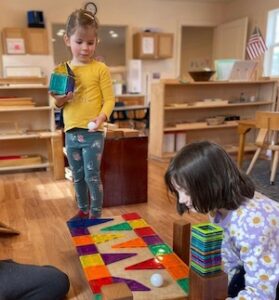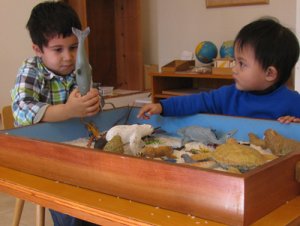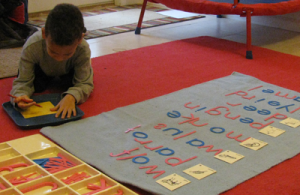“Optimal learning and growth occurs at the right time and place when one is ready and willing to receive, coming forth with both hands open. Children are in that state naturally and thus must be provided for properly in the right environment.” – J.E. Rash
“Help me to do it by myself”….the words of a Montessori child.
Montessori Primary Classroom
- Multi-age classroom for children ages 2 ½ – 6
- Extended day (until 3:30) for 5 – 6 year olds (kindergarten)
- AMI Certified Teachers
 Over 100 years ago Maria Montessori recognized the preschool years as the foundation for a lifetime of learning for the child, indeed for the very person the child will become as an adult. The vital importance of the work of the child during these years led her to develop a philosophy and method that are now used in preschools all over the world.
Over 100 years ago Maria Montessori recognized the preschool years as the foundation for a lifetime of learning for the child, indeed for the very person the child will become as an adult. The vital importance of the work of the child during these years led her to develop a philosophy and method that are now used in preschools all over the world.
Montessori observed that the child learns best through the work of the hand, through the senses, and through movement. The Montessori preschool environment is carefully prepared with sensorial, manipulative materials used to teach the curriculum. The teacher guides the child with lessons in how to use the materials and the child is then encouraged to choose purposeful work, giving her the opportunity to follow her inner guide, making the learning experience individual to each unique brain.
Practical life activities such as washing a table, sweeping the floor, cutting a carrot, pouring water, and sewing teach the young child to be independent and responsible. In addition, they develop control of movement, concentration, eye-hand coordination, and self-confidence, skills and qualities necessary for learning in every area of the curriculum.
The young child has a special sensitivity to learning language and math concepts. The Montessori environment is rich in materials designed to allow the child to explore these areas as she becomes interested and ready. They also provide a solid foundation for the elementary years.
 The cultural subjects of geography, plant and animal study, and science experiments are of great interest to the child. These subjects are explored outside and inside the classroom through activities such as puzzle maps of the continents, classroom animals, clay and water landform construction, and nature walks in the beautiful grounds surrounding the school.
The cultural subjects of geography, plant and animal study, and science experiments are of great interest to the child. These subjects are explored outside and inside the classroom through activities such as puzzle maps of the continents, classroom animals, clay and water landform construction, and nature walks in the beautiful grounds surrounding the school.
Lessons on grace and courtesy help the child develop respect for himself and others. These lessons may be as simple as how to open and close a door quietly or how to greet a visitor and introduce oneself.
Art and music activities are woven into all aspects of the classroom life with songs, instruments, story illustrations, lessons on learning art skills such as cutting and painting, and the sensorial bell material.
See info about our Kindergarten program for 5 year olds
Kindergarten

Kindergarten is available to children 5 to 6 years of age. The younger children leave at 12:00, but the older children have lunch together and continue to work in the classroom until 3:30.
During the afternoon hours, the extended day student receives advanced lessons in language and math and participates in group projects in areas of special interest such as:
- science experiments
- space exploration
- plant and animal study
The multi-age classroom is beneficial to everyone. The younger child has the model of the older child and watches with great interest the higher-level work he will be doing some day. The older child has the opportunity to be the leader and to take more responsibility. He may even help the younger child with lessons, getting a review himself in the process. Having the same teacher throughout these years allows the child and the teacher to develop a close relationship in the learning environment.
